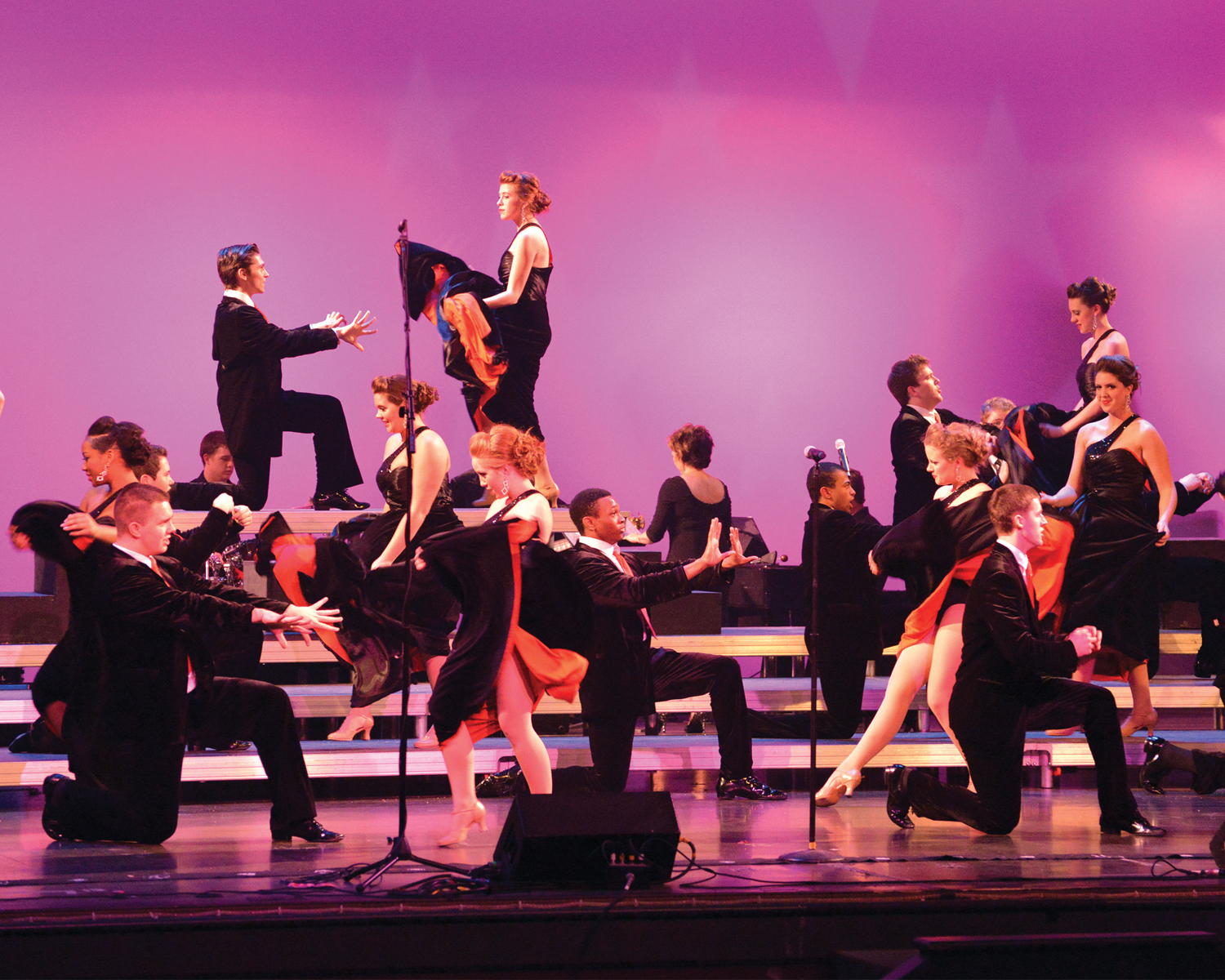
To maximize your success, I recommend focusing on four key areas that will help your program realize its full potential and “P-A-C-E” the year ahead: Preparation, Attitude, Creativity and Equipment. This will ensure successful strides throughout the entire school year.
Preparation
One reason we put off preparing for the new school year is fear: fear of the unknown and fear of failure. As show choir directors, we rationalize that if we wait long enough, maybe “it” will go away, or some perfect new song idea with matching lesson plan will drop out of the sky and appear on our music stand. We justify our postponing by saying we deserve a break, and we shouldn’t have to spend more hours preparing than other teachers. I will be starting my 30th year of teaching, and I am here to tell you that the school year will be here sooner than ever, with bigger challenges to face. Most importantly, your students will be in their places ready to rehearse. Yes, the faces will be different but your students will be ready to go, and you better be prepared for them the second they walk into your rehearsal.
In fact, being over-prepared nowadays is a necessity. What if your best tenor moves out of state, your accompanist has carpal tunnel syndrome, and you are now sharing your budget with the football coach? Prepare and have Plan B in place. As long as you trust your vision and can sell it, your customers (students, faculty, administration, parents) will buy into it as well. You have to believe and be excited about the future. X = X. Whatever you say, do, and think will be mimicked and picked up by those around you.
Attitude
For a show choir to thrive, attitude is everything, and teamwork is a must. Students who respect and trust each other will rehearse better, perform better, travel better and have more fun. I developed my Icebreaker workshops and books to energize rehearsals with fun activities that help students appreciate and celebrate each other. The more you demonstrate care and concern for students as individuals, the more they will care and respect you, your program and each other. Strive to create a welcoming environment, remembering that your classroom may be the only “home” some students know.
At Butler Community College, my show choir, the Butler Headliners, starts each school year with a weekend leadership retreat. We use this time to get to know each other and begin building a cohesive ensemble. Daily team-building exercises are continued throughout the year. When students feel part of a team, they feel safe and are able to participate more fully in the ensemble experience.
I believe an attitude of gratitude is also vital for success. Popular culture today bombards students, indeed all of us, with messages of entitlement and a demand for instant gratification. Sharing common experiences can foster gratitude. Instead of giving a written final, I take the Headliners to perform at a school for severely handicapped students. I ask the music teacher at this school to teach my students a song with sign language so we can all “sing and sign” together. The Headliners walk away knowing they have shared their talents and, instead of complaining about their insignificant problems, they are filled with gratefulness—for things they had previously taken for granted. In that short performance, the audience taught us the attitude of gratitude. The students learned life lessons through their performing and were reminded to count their blessings.
Creativity
Creativity begins with the selecting of music and programming, which should always strive for a balance between respect and risk. First and foremost, respect your audience. I consider the “middle school” approach when programming. Answer these questions when planning your next show: Will the average middle school student be happy sitting through a three-hour production? Will those students get restless when they don’t hear one word sung in their native language? Will the constant motion lull them to sleep? Don’t subject middle school students, or any audience members, to such an agonizing performance experience.
For years I programmed excessively long concerts, hoping every audience member would walk away whistling some tune. Even better, I hoped at least one special song would touch their souls. Of course I wasn’t sure which piece that was, and not wanting to hurt budding musicians, I kept adding selections to the program. I’ve learned in my thirty-year career that audiences can make it about 90 minutes before they get disruptive. The directors and performers are actively participating, but the audience is expected to remain motionless and not contribute except for politely applauding when expected. If we want better audience etiquette, then it is up to us as directors to deliver a creative format for our audience.
Performances should be tailored to the audience. I use a “balanced diet” approach, serving up a wide repertoire that appeals to a cross-section of people. While I’m a big Barry Manilow fan, I know programming a concert with only Barry Manilow tunes would send non-Barry fans running for the exits!
Creativity without risk-taking rarely inspires anyone, but taking risks should not be an end in itself. When I first started adjudicating (before the days of social media), there was a more defined variation in show choir styles. Different parts of the country were recognized for their own style and traditions. Today, due to the prevalence of social media, show choirs are more homogenous—a winning group quickly spawns imitators.
The Internet does have its benefits. For inspiration, explore the online trove of video clips showing various dance styles, from jazz funk to Fosse and from swing to soft shoe. However, don’t settle for the small-screen experience. Attending live theatre is one of the most gratifying and memorable experiences for people of all ages. Researching on the Internet and attending live theatre are both great, but trust yourself as the creative genius. No one knows your students, audiences, venues, or vision, like you—the director.
Equipment
Once you’ve formed a cohesive team and selected the appropriate programming, be sure that when the curtain goes up your risers don’t let you down. There are aesthetic and functional factors to consider with this vital equipment. Aesthetically, adding different levels with risers makes an enormous difference for the audience. In effect, you are lifting up the picture you’ve created. In addition, sound projection to the audience is improved by the tiered arrangement of singers. Without levels, the sound is decreased by being absorbed into the backs of fellow performers. The black skirting on our risers provides a clean, finished appearance. When the Headliners tour, the skirting enables costumes, props, instrument cases and sometimes, even performers to be hidden from the audience.
At any elevation, concerns about riser functionality should be paramount, starting with safety. With my students dancing, tapping, performing gymnastics, and tricks and lifts on the risers, it’s very important that they feel completely safe and secure. Once in a while when judging, I’ve witnessed showchoirs dancing on contraptions that didn’t seem solid or professional. If performers are nervous about the safety and sturdiness of the platform, they will not perform to the best of their abilities. The audience will also be nervous and not concentrate on the performance. The 120-voice Butler Concert Choir uses our risers with complete confidence. Collectively, the members weigh more than seven-and-a-half tons.
Along with legs at the four deck corners, our new risers feature a fifth leg mounted in the center of the deck, providing greater strength and stability. The deck texture provides just enough traction while enabling effortless footwork and turning. Ease of handling is important, particularly for contests when changeover time is limited to 2-3 minutes. The Headliners have hosted various competitions and festivals. Our goal is to help the groups spend time performing, not setting up. During touring season, the Headliners might have three performances a day at three separate venues which means lots of loading, unloading and setting up of risers. Saving minutes certainly adds up. With teamwork, practice, and the right risers, we’ve refined procedures to the point that our changeover operation was described by one audience member as “a well-oiled machine.”
P-A-C-E Setter!
No matter what musical path you choose, take steps for the best year yet. Prepare early, cultivate a positive attitude, create intentionally, and equip your students for a successful future. Best of luck and “PACE” out!











